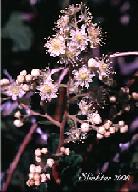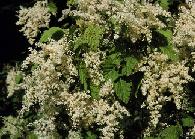
Bushy Oceanspray
Holodiscus dumosus (Nutt. ex Hook.) A. Heller
Bushy oceanspray is a moderately long-lived, native,
deciduous, drought-tolerant shrub that typically ranges from 20 to 60 inches in
height. Plants are densely to intricately branched from the base. The majority
of the foliage originates on spur branches with leaves in fasicles of six or
seven. The root system is fibrous and spreading. This species is
characteristically found in large clumps. The twigs are often reddish, while the bark of older branches may
be a deep grayish-red. The greenish, glabrous to hairy leaves are often
clustered (6-7) at the ends of short spur branches, or found alternating on
newer, long branches. The leaf blades may be up to 3/4 inch in length and may have
up to 15 shallow teeth. The small white flowers (5 petals)
, and
found in a few to several branched panicle. The latter may sometimes be replaced
by a racemose inflorescence. Each of the petals is elliptic-oval in shape. The numerous stamens are about equal in length to the petals.
IT is most often associated with dry, rocky habitats. In the Great Basin
this shrub is ubiquitous in numerous plant communities from desert valleys to
areas well up in the mountains; it is most abundant at elevations between 4,500
and 11,000 feet. Typical sites include rocky outcrops, slickrock plateau
margins, bases of cliffs, talus slopes, and steep, canyon walls. Soils are dry
to moderately dry, and well drained; textures range from sand to clay. Plants
appear somewhat tolerant of alkaine. Located in rocky places, often in woodland and scrub, 1400-3000 mountain
elevations. This species is a pioneer on young lavas in southern Idaho.
Plants establish during early seral stages and coexist with later arriving
species that are also adapted to such severe site conditions.
Food Uses
The fruit, which is small and dry, may be used raw or cooked.. The
leaves can be steeped in water to make a tea.
Medicinal Uses
A decoction of the root has been used in the
treatment of diarrhoea and stomach disorders. A decoction of the stems has been
used in the treatment of colds and stomach disorders. A decoction of the
flowers, leaves and stems has been used as an antiseptic wash.
Growth
Succeeds in a good loamy soil that does not become too dry in
summer in full sun or light shade. The seed requires 4
months stratification at 4°cIt is best sown as soon as it is ripe in a cold
frame. Stored seed should be sown as early in the year as possible. When they
are large enough to handle, prick the seedlings out into individual pots and
grow them on in the greenhouse for at least their first winter. Plant them out
into their permanent positions in late spring or early summer, after the last
expected frosts. Can be grown from cuttings of half-ripe wood with a heel,
July/August in a frame. May be difficult. (PFAF)

Return
to main plant page


